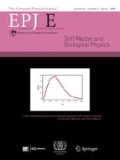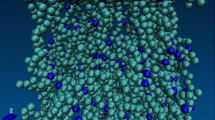Abstract.
By means of molecular dynamics simulations we demonstrate power laws for macroscopic transport properties of strongly compressed polymer-brush bilayers to stationary shear motion beyond the Newtonian response. The corresponding exponents are derived from a recently developed scaling theory, where the interpenetration between the brushes is taken as the relevant length scale. This allows to predict the dependence of the critical shear rate, which separates linear and non-linear behavior, on compression and molecular parameters of the bilayer. We present scaling plots for chain extension (R , viscosity (\( \eta\) , and shear force (F over a wide range of Weissenberg numbers, W . In agreement with our theory, the simulation reveals simple power laws, R ∼ W 0.53 , \( \eta\) ∼ W -0.46 , and F ∼ W 0.54 , for the non-Newtonian regime.
Similar content being viewed by others
References
J. Klein, D. Perahia, S. Warburg, Nature 352, 143 (1991)
J. Klein, Annu. Rev. Mater. Sci. 26, 581 (1996)
P.A. Schorr, T.C.B. Kwan, S.M. Kilbey II, E.S.G. Shaqfey, M. Tirrell, Macromolecules 36, 389 (2003)
J. Klein, Proc. IMechE J. 220, 691 (2006)
J. Klein, Science 323, 47 (2009)
M. Murat, G.S. Grest, Phys. Rev. Lett. 63, 1074 (1989)
P.-Y. Lai, K. Binder, J. Chem. Phys. 98, 2366 (1993)
P.S. Doyle, E.S.G. Shaqfeh, A.P. Gast, Phys. Rev. Lett. 78, 1182 (1997)
P.S. Doyle, E.S.G. Shaqfeh, A.P. Gast, Macromolecules 31, 5474 (1998)
T. Kreer, K. Binder, M.H. Müser, Langmuir 19, 7551 (2003)
F. Goujon, P. Malfreyt, D.J. Tildesley, Chem. Phys. Chem. 5, 457 (2004)
F. Goujon, P. Malfreyt, D.J. Tildesley, Mol. Phys. 103, 2675 (2005)
F. Goujon, Dissertation (Clermont-Ferrand, 2003)
C. Pastorino, T. Kreer, M. Müller, K. Binder, Phys. Rev. E 76, 026706 (2007)
A. Galuschko, L. Spirin, T. Kreer, A. Johner, C. Pastorino, J. Wittmer, J. Baschnagel, Langmuir 26, 6418 (2010)
J.-F. Joanny, Langmuir 8, 989 (1992)
F. Clement, T. Charitat, A. Johner, J.-F. Joanny, Europhys. Lett. 54, 65 (2001)
M. Rubinstein, S.P. Obukhov, Macromolecules 26, 1740 (1993)
T. Moro, Y. Takatori, K. Ishihara, T. Konno, Y. Takigawa, T. Matsushita, U. Chung, K. Nakamura, H. Kawaguchi, Nat. Mater. 3, 829 (2004)
R.C. Advincula, W.J. Brittain, K.C. Caster, J. Rühe (Editors), Polymer Brushes (Wiley, 2004)
R. Everaers, S.K. Sukumaran, G.S. Grest, C. Svaneborg, A. Sivasubramanian, K. Kremer, Science 303, 823 (2004)
We anticipate that the entanglement length for directed chains in a brush is expected to be larger than for bulk systems
K. Kremer, G.S. Grest, I. Carmesin, Phys. Rev. Lett. 61, 566 (1988)
P.J. Hoogerbrugge, J.M.V.A. Koelman, Europhys. Lett. 19, 155 (1992)
P. Espanol, P. Warren, Europhys. Lett. 30, 191 (1995)
A detailed discussion about the performance of the DPD thermostat in non-equilibrium MD simulations of polymer brushes can be found in ref. claudio and in P. Virnau, K. Binder, H. Heinz, T. Kreer, M. Müller, Encyclopedia of polymer blends Vol. I: Foundamentals, edited by A.I. Isayev (Wiley-VCH, Weinheim, 2010)
All lengths are measured in Lennard-Jones units
T. Kreer, S. Metzger, M. Müller, K. Binder, J. Baschnagel, J. Chem. Phys. 120, 4012 (2004)
T.A. Witten, L. Leibler, P.A. Pincus, Macromolecules 23, 824 (1990)
P.G. de Gennes, Scaling Concepts in Polymer Physics (Cornell University Press, 1979)
In this context, the limit of ``strong'' compression does not imply melt conditions. Instead, we refer to a semidilute bilayer with a uniform monomer density profile
In fact, previous investigations kreer, where hydrodynamic interactions were strongly screened due to the application of a different (Langevin) thermostat, report a somewhat larger exponent, $R^2/R^2_0 \sim W^{0.6}$. This can be understood from our approach by reformulating eq. (Fwet.eq) for ``dry'' bilayers. Without hydrodynamic interactions, the force per area in linear response is proportional to the number of monomers in the interpenetration zone, $F/A \sim cL\dot{\gamma} D$. Repeating our analysis we obtain $R^2/R^2_0 \sim W^{0.65}$, $F/F(W = 1)$ $\sim W^{0.73}$, $\eta/\eta_0 \sim W^{-0.27}$ for the non-Newtonian response of semidilute, dry bilayers. Note that these exponents clearly differ from the present approach giving rise to the assertion that hydrodynamic interactions are represented in our simulations for all solvent models used. Dry bilayers, as modeled in ref. kreer, are physically much less relevant, of course
Note that experimental shear rates are usually much smaller than in the simulation. On the other hand, simulations typically work with much smaller chain lengths. Equation (tau.eq) suggests that both effects partially cancel, such that the related Weissenberg numbers become comparable
Author information
Authors and Affiliations
Corresponding author
Rights and permissions
About this article
Cite this article
Spirin, L., Galuschko, A., Kreer, T. et al. Polymer-brush lubrication in the limit of strong compression. Eur. Phys. J. E 33, 307–311 (2010). https://doi.org/10.1140/epje/i2010-10674-3
Received:
Accepted:
Published:
Issue Date:
DOI: https://doi.org/10.1140/epje/i2010-10674-3



